Ecosystems Unit 1 Test
1/99
There's no tags or description
Looks like no tags are added yet.
Name | Mastery | Learn | Test | Matching | Spaced |
|---|
No study sessions yet.
100 Terms
transpiration
the process of water movement through a plant and its evaporation from aerial parts, such as leaves, stems and flowers.
runoff
the part of the water cycle that flows over land as surface water instead of being absorbed into groundwater or evaporating.
symbiosis
a close interaction between two different species where at least one organism benefits from the relationship.
paratism
symbiotic relationship between species where one species benefits at the expense of the other.
competition
Two or more individual organisms of a single species(intraspecific competition) or two or more individuals of different species (interspecific competition) attempting to use the same scarce resources in the same ecosystem.
biogeochemical cycle
cycle of matter between biotic and abiotic things in the environment involving biological, geologic and chemical interactions; they are driven by energy and gravity. carbon cycle. (nitrogen, phosphorus, carbon, and water)
ecosystem
Community of different species interacting with one another and with their nonliving environment of matter and energ
anthropogenic
caused or produced by human activities. Sources of ______ greenhouse gas emissions include the burning of fossil fuels, deforestation, raising of livestock, use of fertilizers, and so on. carbon sequestration.
nitrification
the process by which ammonia and other nitrogen compounds are converted into nitrite (NO2) and nitrate (NO3). _____ is carried out by bacteria in soil and water.
carnivore
an organism that mostly eats meat, or the flesh of animals. Sometimes _____ are called predators. Organisms that _______ hunt are called prey. ______ are a major part of the food web, a description of which organisms eat which other organisms in the wild.
food web
a complex network of interconnecting and overlapping food chains showing feeding relationships within a community. A food chain shows how matter and energy from food are transferred from one organism to another, whereas a food web illustrates how food chains intertwine in an ecosystem.
gross primary production
rate at which photosynthetic primary producers incorporate energy from the sun.
net primary productivity
energy that remains in the primary producers after accounting for the organisms' respiration and heat loss.
consumer
an organism that cannot produce its own food and must eat other plants and/or animals to get energy.
climate
the long-term, predictable atmospheric conditions of a specific area. The ____ of a biome is characterized by having consistent temperature and annual rainfall ranges.
wetlands
areas where water covers the soil, or is present either at or near the surface of the soil all year or for varying periods of time during the year, including during the growing season.
intertidal zone
the area where the ocean meets the land between high and low tides.
infiltration
the process by which water on the ground surface enters the soil.
precipitation
any form of water that falls from clouds and reaches Earth's surface.
competitive exclusion
only one species can occupy an ecological niche. This means that there cannot be two species that have the exact same ecological niche in the same ecosystem.
commensalism
a relationship between species where one benefits and the other remains unaffected.
mutualism
an interaction that benefits both species.
habitat
the natural home or environment for a human, animal, or organism.
photosynthesis
The process by which producers use solar energy to convert carbon dioxide and water into glucose.
ammonification
a host of decomposing microorganisms, such as bacteria and fungi, break down nitrogenous wastes and organic matter found in animal waste and dead plants and animals and convert it to inorganic ammonia (NH3) for absorption by plants as ammonium ions.
nitrogen fixation
the conversion of atmospheric nitrogen (N2) into reactive. compounds such as ammonia (NH3) and nitrate (NO3. - ). The breaking of the bonds.
omnivore
an animal or person that eats food of both plant and animal origin.
herbivore
an animal that feeds on plants.
feedback loop (+)
occurs in nature when the product of a reaction leads to an increase in that reaction.
feeback loop (-)
occurs in biology when the product of a reaction leads to a decrease in that reaction.
decomposer
organism that digests parts of dead organisms, and cast-off fragments and wastes of living organisms by breaking down the complex organic molecules in those materials into simpler inorganic compounds and then absorbing the soluble nutrients.
biome
large distinct terrestrial region having similar climate, soil, plants & animals.
mangrove forest
a group of tropical and subtropical trees and shrubs that live in the coastal intertidal zone and are adapted to lose, wet soils, salt water, and being periodically submerged by tides.
benthic
bottom of an aquatic ecosystem; consists of sand and sediment and supports its own community of organisms. coastal wetland. Land along a coastline, extending inland from an estuary, that is covered with salt water all or part of the year.
evaporation
the process by which water changes from liquid form to an atmospheric gas.
niche
a habitat and way of life to which a particular organism is adapted. It is the role of a particular species within an ecosystem, including all aspects of its interaction with the living and nonliving environments.
resource partioning
when different organisms within one ecosystem split up an area so that they will not compete for the same resources and when those organisms have a special adaptation.
sequester
An approach that involves taking CO2 out of the atmosphere, then storing it in agricultural soils and allowing it to become a pasture or forest.
predation
when a member of one species feeds directly on all or part of a member of another species.
trophic level
An organism's position in a food web. It is based on food and or feeding.
cell respiration
The process by which cells convert glucose and oxygen into energy, carbon dioxide, and water.
assimilation
the process of incorporating a nutrient into an organism's cells.
denitrification
he process by which nitrate is reduced to nitrogen gas by soil microbes when oxygen is not present. This process is vital to the recycling of nitrogen for soil health, microbial and plant growth, and animal health.
limiting factor
Single factor that limits the growth, abundance, or distribution of the population of a species in an ecosystem.
resource partitioning
when different organisms within one ecosystem split up an area so that they will not compete for the same resources and when those organisms have a special adaptation.
riparian
the transition zone between fully terrestrial and fully aquatic systems.
coral reef
an underwater ecosystem characterized by reef-building corals. Reefs are formed of colonies of coral polyps held together by calcium carbonate.
estuary
a coastal body of water partly surrounded by land with access to open ocean and a large supply of fresh water from a river/stream.
autotroph (producer)
an organism that uses solar energy (green plants) or chemical energy (some bacteria) to manufacture the organic compounds it needs as nutrients from simple inorganic compounds obtained from its environment.
Symbiosis - a relationship between two species
Mutualism - both species benefit from the relationship (EX: Acia tree and ants —> the trees get protection while the ants get food/a home)
Commensalism - One of the species benefits while the other is not harmed or benefited (EX: whales and barnacles —> the barnacles live on the whale for their habitat and the whale is not affected)
paratism - one species is benefited while the other one is harmed (EX: tapeworms and cows, pigs, and or humans —> the tapeworm gets food/an environment to live and the cows, pigs, and humans get sick and can even die as a result)
Describe symbiosis. Define the three types (mutualism, commensalism, & parasitism) and give examples.
Competition - when individuals from the same or different species struggle to get the same limiting resource (a resource that is biotic or aibiotic that could stop a population from growing)
Resource partioning - species use the limiting resource in many ways to reduce competition (EX: different species of birds use different parts of the same tree)
temporal partioning - multiple species rely on the same resources but their niches (the role of an organism in it’s habitat) are separated by the time that they are active (EX: Owls and hawks eat the same prey but hunt at different types of day)
spatial partitioning - occurs if species differ in where they acquire resources and can happen both above- and belowground (EX: closely related bird species occupy different heights on the same tree)
morphological partitioning - species lower competition by evolving different adaptations in body and shape
Describe competition. Define resource partitioning. Explain how it reduces competition. Identify the three types of resource partitioning.
Photosynthesis - Carbon dioxide (CO2) + sunlight (energy) + water (H2O) —> glucose (C6H12O6) + Oxygen (O2)
Cellular Respiration - Oxygen (O2) + glucose (C6H12O6) —> Carbon dioxide (CO2) + Water (H2O) + ATP
Photosynthesis makes glucose which is used in cellular respiration for making ATP. The glucose is then transformed back into carbon dioxide, which is used in photosynthesis. It helps cells to release and store energy. It maintains the atmospheric balance of carbon dioxide and oxygen.
Give the word equation for photosynthesis and cell respiration. Know which one adds CO2 to the atmosphere and which one removes it. How do they connect to one another?
1st (Bottom) - producers (use sunlight to make food/energy —> EX: grass)
2nd - primary consumers (eat the producers —> EX: rabbits)
3rd - secondary consumers (eat the primary consumers —> EX: snakes)
4th (top) - teritary consumers/apex predators (consume the secondary consumers —> EX: hawks)
Decomposeres - break down dead organisms for nutrients for themslevs that evntually goes back to the environment (EX: worms)
Draw a trophic pyramid and label the trophic levels. Put one example organism on each level. Be sure to include decomposers.
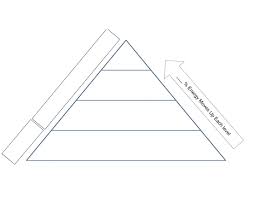
RIGHT ANSWER FOR FOOD WEB QUESTION
Know how to draw a food web
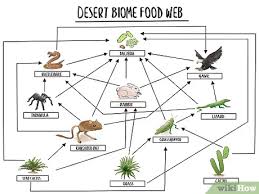
Competition: - and -
Commensalism: + and 0
Mutualism: + and +
Paratism: + and -
Predation: + and -
Fill out this chart (negative = -, positive = +, and no effect = 0) - make sure that you can identify the type of species interaction from a description or data, and that if given the interaction type, you can predict the impact on both species of a change in the other species’ population. (LOOK UP EXAMPLES)

Carbon Cycle
What is this a diagram of?
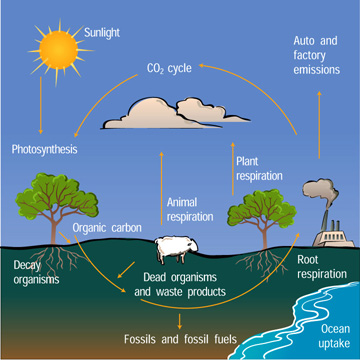
Nitrogen Cycle
What is this a diagram of?
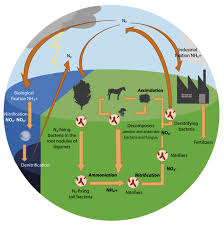
Phosphorus Cycle
What is this a diagram of?
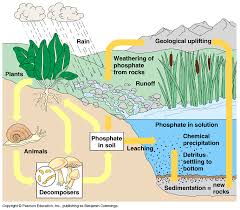
Water Cycle
What is this a diagram of?
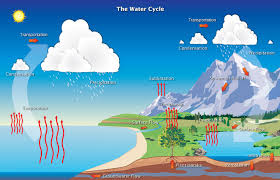
Plants go through phtotsynthesis, taking in O2 and realising CO2 —> primary consumers eat the plants and go through respiration which releases the CO2 back into the atmosphere and becomes a green house gas —> extraction/burial (carbon dioxide also gets into the atmoshpere through the burning of fossil fuels) —> combustion (the carbon from the fuel combines with the oxygen in the air to release carbon dioxide (CO2) and water vapour (H2O)
Major reservoirs - atmospheres, oceans, soil, and fossil fuels
Impact - burn wood, fossil fuels (such as oil, coal, and natural gas), and other forms of carbon. This action releases the stored carbon into the atmosphere, where it becomes a greenhouse gas. Greenhouse gases are gases in the atmosphere that absorb and release heat.
Describe the carbon cycle. Major reservoirs? Impact people have on each?
First nitrigen fixation occurs (the N2 from the atmosphere turns into (ammonia) NH3 —> assimilation (nitrates assimiate into the plants and the consumers eat those plants) —> the consumers die and start to decay which releases NH4+ (ammonium) —> nitification turns the NH4+ back into NH3 and N2 —> nitrigen then leeches into the water —> eutrphication (Nitrogen from fertilizers sinks into soils, often creating conditions that favor the growth of weeds rather than native plants. Nitrogen then washes into waterways, causing a surplus of nutrients) —> denification (bacteria returns the N2 to the atmosphere)
Major reservoirs - atmosphere
Impact - Burning fossil fuels and the application of nitrogen-based fertilizers
Describe the nitrogen cycle. Major reservoirs? Impact people have on each?
weathering and erosion releases phosphates contained in soils and sedimentary rocks. These phosphates are absorbed by plants, which in turn are consumed by animals —> animals die and start to decay and go back into the soil which runs into the water —> the phosphate sediments are uplifted in the water and back into the plants
Major reservoirs - ocean sediments
Impact - mining phosphorus (P) and transporting it in fertilizers, animal feeds, agricultural crops, and other products—are altering the global P cycle, causing P to accumulate in some of the world's soil.
Describe the phosphorus cycle. Major reservoirs? Impact people have on each?
A source of water is either evaporated, transpirated (the process by which plants give off water vapor through the stomata in their leaves), or evaportanspirated (the sum of all processes by which water moves from the land surface to the atmosphere via evaporation and transpiration) —> condensation (water vaopr condenses into clouds, dew, or fog) —> precipitation —> infiltration/ rehcarge (the physical process involving movement of water through the boundary area where the atmosphere interfaces with the soil) —> percolation (the movement of water through the soil itself) —> ground water (water that soaks into the soil and is stored between the spaces between the rocks and soil particles) —> runoff
Major reservoirs - oceans, lakes, rivers, trees, glaciers, atmosphere
Impact - burning fossil fuel, contributes to the Earth's rising temperature. An increase in temperature means an increase in evaporation and rapid melting of ice sheets, such as glaciers, which causes sea levels to rise and impacts other critical processes of the water cycle.
Descirbe the water cycle. Major reservoirs? Impact people have on each?
SUNLIGHT!!!!!
What is the primary source of energy for all life on earth?
1st Law - Often called the Law of Conservation of Energy. This Law states that energy cannot be created or destroyed, it just changes forms as it is transferred from one level to another. Thus, the total amount of energy available in any system is constant. (EX: Sunlight —> photosynthesis)
2nd Law - As energy changes form, it moves from more useful forms to less useful forms. It gets degraded as it moves from a higher energy state to a lower energy state (usually heat). Energy flows in one irreversible direction. It cannot be recycled or reused. (EX: Trophic Levels)
Briefly define the first two laws of thermodynamics and explain how they relate to environmental science.
The source is the flux of material into a reservoir, and the sink is the amount of material removed from it.
Distinguish between a source and a sink in a biogeochemical cycle
it generally does not circulate through the atmosphere
What is the major difference between the phosphorus cycle and the other biogeochemical cycles?
low availability due to slow diffusion and high fixation in soils. All of this means that P can be a major limiting factor for plant growth.
Why is phosphorus a limiting factor for plant growth?
when energy is passed in an ecosystem from one trophic level to the next, only ten percent of the energy will be passed on
Take 10% from what the trophic level is and so on (EX: 10% of 1000 is 100 and so on)
What is the 10% rule? How can you use it to determine the amount of energy available to an organism at a given level of the trophic pyramid?
GPP (Gross Primary Produtivity) - R (Cellular Respiration of Producers) = NPP (Net Primary Productivity)
What is the formula for calculating net productivity?
ANSWER FOR LAYERS OF LAKE
Draw and label the layers of a lake (do on seperate peiece of paper)
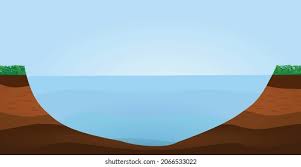
ANSWER FOR LAYERS OF OCEAN
Draw and label the layers of a ocean (do on seperate peice of paper)
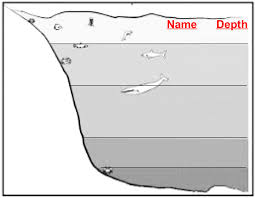
litoral zone
water meets the land. Plants here support wildlife such as wading birds, turtles and crabs.
limnetic zone
the layer that receives sufficient sunlight, allowing for photosynthesis (photic zone)
profundal zone
the area in a deep lake where no light reaches, so photosynthesis is not possible there. Biological activity in the form of bacteria use oxygen to break down organic matter.
benthic zone
sediments at the seafloor. These sediments play an important role in providing nutrients for the organisms that live in the ____ zone.
intertidal zone
between avg high and low tide over continental shelf, dry/wet as the tides change, sunlight penetrates
pleagic zone
avg low tide of ocean and edge of continetal shelf, sunlight penetrates
oceanic zone
all ocean beyond the interidal and pleagic zones
photic zone
sunlight pentrates —> plants like algae do photosynthesis
twilight zone
insufficient sunlight, planst dont grow
midnight zone
all animals are scavengers
abyssal zone
completely dark, HIGH pressure
hadel zone
deepest region, trenches
Tundra
cold/dry, north of 60°, lichens, mosses, short grasses, ox, caribou, shorebirds, low productivity
temperate grassland/prairie
warm/moderate, 30°-40° mid continents, grasses, scattered trees, hoofed animals, medium productivity
desert
hot/dry, 30°N and S, cacti, other succulents, insetcs, scorpions, reptiles, lowest productivity
temeprate rainforest
warm/wet, costal, mid-lats, perennials, conifer (needle) trees, wolves, moose, and beavers, med/high productivity
savanna
warm/wet/dry seasons, desert —> forest, grasses, scattered trees, hoofed animals, medium productivity
scrubland/Chaparral
hot/dry sumers, mild/rainy winters, Argentina, Cali, Mediterranean (costal), small shurbs, reptiles, deer, rabbits, squirrels, medium producitivty
tropical rainforest
hot/wet, equator, broadleaf trees, ferns, vines, flowers, primates, cats, snakes, birds, insects, very high productivity
temperate seasonal forest
warm/moderate, eastern side of continents (30°-40°), deciduous trees, shrubs, flowers, deer, squirrels, songbirds, high proudctivty
taiga/boreal forest
cold/wet, 50-60° N, redwoods, ferns, mosses, low productivity
streams
Salinity - none/fast, very small fish, invertebrates, no zones, medium productivty
rivers
Salinity - none/medium, trout, salmon, catfish, zones depend on flow speed, high productivty
ponds/lakes
Salinity - none/still, freshwater fish/plants, turtles, frogs, algae, littoral, limnetic, profundal, and benthic zones, low or high productivty
wetland
Salinity - none/low/still, baby fish, birds, insects, emergent plants/trees, N/A zones, very high productivty
open ocean
Salinity - 35 ppt/currents, phytoplankton, large fish, mammals, N/A zones, low productivity
salt marsh/estuary
Salinity - brackish/tidal, mollusks, crustaceans, baby fish, and birds, N/A zones, very high productivty
coral reef
Salinity - 35 ppt/current and wave actions, high biodiversity, N/A zones, very high productivity